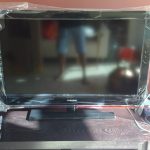
Samsung has a good reputation for their LCD TVs (and for their LED TVs too), so it is no wonder that the picture quality is that good. Quality comes with a price, of course, and personally I thought that Samsung LCD TVs are pricey compared to other competitive models of similar specifications. I had not set out to buy a Samsung TV, but I surprised myself by ultimately deciding on a Samsung.
I was actually considering the Sharp Aquos LC-42A77M. But the salesman at Best Denki recommended that I take a look at this Samsung model. The plus point? Picture quality, built-in HD tuner (i.e. no need for a separate HD set-top box), and the freebies. Samsung is offering a 26″ LCD TV along with the purchase of this TV. Sounds like an attractive proposition. But at $1799, it costs $200 more than the Sharp I was eyeing. I don’t need another 26″ TV, no point to pay $200 more.
The built-in HD tuner is not really that useful either. I connect my TV to StarHub Digital Cable. If I want HD, I would probably go with StarHub HD set-top box. The built-in HD tuner would be unnecessary.
The plus point for the Sharp is that it has a 100Hz engine, while the Samsung is 50Hz only. However, with LCD panels, the Hz doesn’t really matter that much because the issue of image flickering that happens with CRT screens is not relevant to LCD panels.
Samsung isn’t very informative with their specifications. For example, their contrast ratio is simply listed as “high”, whereas the Sharp lists 50000:1 (which seems pretty good compared with available specifications of other LCD TVs). The Sharp LC-42A77M is also 2″ larger than the Samsung. However, I’m told that all new panels are standardizing on 40″ dimensions rather than 42″.
This TV model number is LA40B530P7M . It is the “B” generation of the Series 5. The older “A” generation would have model numbers which go something like “LAxxAxxx…”. I guess “B” would be better than “A”, although I don’t know specifically in what way.
Now that the TV is here, what do I think of it? Well, as I said at the start, the picture quality is superb. The black is so black, so much that the menu screens which had some parts in black background blended in with the bezel around the screen, and the stickers that came stuck around the bezel. It was really good. The brightness was similarly so good that the picture was still relatively clear despite the afternoon sun falling on the screen.
The audio quality isn’t much to boast about. The sound is crisp and clear, but there is not much bass. I suppose for wholesome sound, you would really need a proper home theatre system matched with a good set of speakers.
The energy saving feature of the TV saves energy by dimming the backlight. In “auto” mode, the backlight is adjusted according to the picture being shown. I find auto mode irritating because of the brightness adjustments can be seen, although perhaps that was because I was looking out for it.
Feature-wise, this TV is pretty simple. No picture-in-picture and channel matrix previews, for example, although not that it matters anyway since those would not work when you get cable TV through a set-top box which controls all the channels.
I hoping to try connecting my PC to this 40″ display some time soon. The latter has a VGA D-Sub input connector for that purpose, and supports resolutions up to 1920 x 1080.
If you’re looking around for a 40″ or 42″ LCD TV, this is something you might want to consider. The 26″ LCD TV freebie is supposedly worth $799. I imagine it should be easy to fetch at least $450. Incidentally, back to the reason why I changed my mind from the Sharp to Samsung? Well, the Sharp comes with 3 years warranty, but I was told the panel warranty itself is only for the 1st year. The Samsung LCD TV is fully covered for 3 years. I thought if I had to pay for extended warranty for the Sharp LCD TV, the price would have almost matched the Samsung’s. In that case, why not get the Samsung then. It has a 26″ LCD TV that has to be worth something. (It seems an alternative freebie to the 26″ LCD TV is a home theatre system.)
